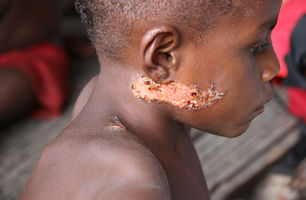
Delivering Healthcare in West Sepik Province

Above/below: two children watch their skin flake off from grille, a fungal ringworm infection widespread in West Sepik. The condition produces extreme itching, and when children scratch their skin, abrasions often become infected and lead to ulcerative skin lesions. A course of medication to treat grille (griseofulvin) can be bought for about $4.

Papua New Guinea's West Sepik Province is a stunningly beautiful place, a landscape overgrown with lowland rainforests and home to the Sepik River, one of the great waterways of PNG. It's also home to numerous cultures who make a living through subsistence hunting and gardening. Due to its remote location, West Sepik remains one of PNG's poorest provinces, and lack of medical resources remains a persistent problem. When diseases such as tuberculosis, HIV, malaria, and buruli ulcers appear, the consequences are often devastating, and aid posts may be days away.
We're teaming up with health workers, doctors, med students, and visionaries in both Papua New Guinea and the United States to launch a new non-profit in early 2019. Called the Sepik Health Alliance (SHA), we plan to make consistent visits to PNG and deliver medications, combine treatment with prevention, and support medical personnel already based in the province.
Above: two examples of ulcerative skin lesions in West Sepik. Without money for shoes or access to clean water, small cuts and abrasions become infected and fester for months, often leading to permanent disfigurement and disability.
Our work began with a simple question: if topical antibiotics and wound dressings were available, could tropical ulcers be caught early and prevented? Could the same medications available for a few dollars in any US pharmacy prevent serious conditions from developing?
After undertaking a pilot project in which we used only basic first aid resources and trained community members to administer first aid, our early results appear promising. A majority of preulcerative lesions were cured, and almost all diminished in size after two weeks. We also transported more serious cases and fully developed buruli ulcers to Vanimo hospital for supervision and treatment.
We're currently looking for med students, physicians, educators, and storytellers interested in joining our team and supporting operations either in Papua New Guinea or in the U.S. The long-term vision is a brick-and-mortar clinic in West Sepik capable of providing sustainable treatment, women's health services, and continuity of care. If you're interested, send an email to Austin at austin.hagwood@gmail.com.




Above: a boy in West Sepik who initially presented with burn wounds. The second photo was taken two weeks later following consistent treatment with triple antibiotic ointment and nonstick bandaging.